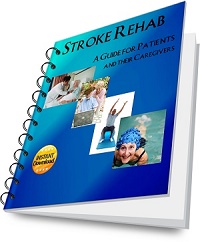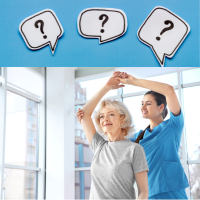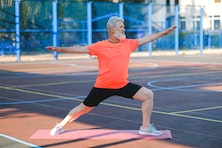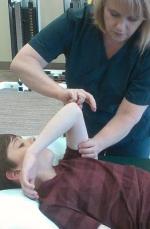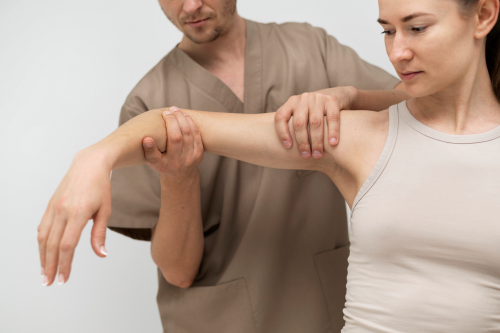Pain After a Stroke
Pain after a stroke is one of the lesser discussed issues stroke survivors face but can be a significant problem and even debilitating for some. Post-stroke pain can manifest in various ways and in different locations and may be difficult to manage. In this article, we will explore the types of pain experienced after a stroke and discuss treatment options including those typically used as well as alternative treatments.
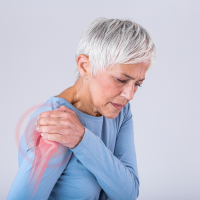
Types of Pain After a Stroke
Neuropathic Pain: Nerve related pain, which is often described as shooting, burning, or tingling sensations. This type of pain can occur anywhere in the body. This type of pain is sometimes referred to as neuropathy or may be further classified as central post-stroke pain which is explained below.
Central Post-Stroke Pain (CPSP): CPSP is characterized by persistent, severe, and often burning or shooting pain on the side of the body affected by the stroke. This type of pain originates in the brain and is due to damage to the central nervous system.
Musculoskeletal Pain: Stroke survivors may experience musculoskeletal pain, which includes muscle stiffness, joint pain, and discomfort resulting from changes in posture and muscle tone due to stroke-related weakness or spasticity.
Shoulder Pain: This is a type of musculoskeletal pain, but is listed separately as it is one of the more common types of pain after a stroke. Many stroke patients develop shoulder pain due to weakened shoulder muscles or improper exercise technique during rehabilitation. This pain can hinder the recovery process and limit mobility.
Headaches: Headaches are a common complaint after a stroke, and they can range from mild to severe. They may be related to changes in blood flow, medication side effects, or stress.
Treatment Options for Post-Stroke Pain
1. Medications
Physicians may recommend or prescribe various medications such as the ones discussed below: (Always check with your physician before taking any medications after stroke)
Analgesics: Over-the-counter pain relievers like acetaminophen or prescription opioids may help manage pain.
Neuropathic pain medications: Drugs like gabapentin or pregabalin are often prescribed for neuropathic pain.
Muscle relaxants: These medications may help alleviate muscle spasms and reduce musculoskeletal pain.
Anti-inflammatory drugs: Nonsteroidal anti-inflammatory drugs (NSAIDs) may help with joint pain and inflammation.
2. Injections and Nerve Blocks
Corticosteroid injections: These can be administered into affected joints or muscles to reduce inflammation and pain.
Nerve blocks: Local anesthetics can be used to block pain signals in specific nerves, providing temporary relief.
Botox Injections: Botox works by blocking the release of acetylcholine, a neurotransmitter responsible for muscle contractions. When injected into spastic muscles, Botox can temporarily relax them, reducing muscle tone which can help alleviate pain.
3. Physical, Occupational, and Massage Therapy
Stroke can lead to muscle imbalances, spasticity, and weakness. These changes affect posture and may lead to pain from structures compressing or placing traction on nerves, bony misalignment such as might occur in the vertebral facet joints and ribs, tight muscles, and weak muscles that give away when placed in weight bearing.
Physical and occupational therapists can perform hands-on techniques to address these issues, improve alignment, decrease tightness, and alleviate pain. They can also focus on improving strength, balance, and mobility, which may help alleviate musculoskeletal pain and enhance overall function. In addition they will educate a patient on proper joint positioning. Finding a therapist with extensive training or certifications in manual therapy as well as stroke may prove beneficial.
Massage therapy can also help relax tight muscles, improve circulation, and reduce pain and tension. A good massage therapist should have you fill out a health history and ask you to submit a medical release from your physician. In addition, it's important if using a massage therapist to make sure they are familiar with the effects of stroke and precautions or contraindications. Ask questions beforehand addressing what previous experience they have in working with spasticity or stroke victims.
4. Graded Motor Imagery
Graded motor imagery (GMI) is a three-step rehabilitation program that focuses on retraining the brain's perception of movement and reducing pain. It involves the following stages:
Laterality Recognition: In this stage, the patient is presented with images of left or right limbs and is asked to identify them quickly. This helps reestablish the brain's connection to the affected limb.
Motor Imagery: The patient practices mentally visualizing and imagining movements of the affected limb without actually moving it. This step helps activate the brain's motor areas.
Mirror Therapy: While performing mirror therapy, the patient uses a mirror to create a visual illusion that the affected limb is moving normally when it's actually stationary. By observing the reflected image of the unaffected limb moving, the brain is "tricked" into perceiving movement in the affected limb.
GMI helps with pain after a stroke by reprogramming the brain's sensory and motor networks, reducing pain perception, and improving motor function. Find out more at https://www.noigroup.com/graded-motor-imagery/
5. Physical Agent Modalities
Transcutaneous Electrical Nerve Stimulation (TENS) devices deliver electrical impulses to nerves through electrodes placed on the skin, which can help reduce pain by interfering with pain signals. There can be contraindications with TENs use, so get approval or a prescription from your physician before using.
Hot or Cold Packs - heat and cold may be used to help with pain, but sensation deficits can be present after stroke (even unknown to the patient), so it's imperative to know if sensation is intact before use.
6. Orthotics and Assistive Devices
The use of orthotic devices or assistive tools can help maintain proper joint alignment and reduce pressure on nerves. These may include:
- Ankle foot orthoses (AFOs)
- Wrist and hand braces (or custom made orthoses by a therapist)
- Knee braces for instability
- Arm slings to support a heavy arm
- Seating cushions to promote better posture
- Orthopedic shoes
- Electric adjustable beds or orthopedic mattresses
- Foot orthotics which could include toe separators, metatarsal pads, heel cups, cushions, or arch supports
- Kinesiotaping
- Canes, walkers, chair lifts, and transfer aids to assist with mobility and weight bearing
Please note that orthotic and assistive devices do not always help with pain and can sometimes lead to more pain, problems with skin breakdown, or joint stiffness and contractures, so it is imperative to discuss with your own healthcare provider what options are best for you.
Alternative Treatments and Therapies for Pain After a Stroke
There are alternative approaches that one can consider for managing post-stroke pain, especially when conventional medical treatments are ineffective. Individual responses to these methods will vary and each individual has their own unique medical history and issues, so consultation with a healthcare professional is recommended before trying alternative treatments. Some of these include:
Acupuncture: Acupuncture is an ancient Chinese practice that involves inserting thin needles into specific points on the body. Many people find relief from nerve pain through acupuncture, as it is believed to stimulate the body's natural pain-relief mechanisms and improve energy flow.
Chiropractic Care: Chiropractic adjustments focus on aligning the spine and relieving pressure on nerves. Chiropractors can work on the musculoskeletal system to reduce pain and improve nerve function. Though infrequent, it is important to note that neck manipulation can cause dissection injuries to the vertebral arteries in the neck which can lead to stroke. It is essential to discuss this risk with your physician before considering this option. You would be especially vulnerable if you are frail/elderly as well if you already had a stroke due to artery dissection.
Biofeedback: Biofeedback techniques involve monitoring and controlling physiological functions, such as muscle tension and heart rate, using electronic sensors. By learning to control these functions, individuals may gain some control over their perception of pain.
Mindfulness Meditation: Mindfulness meditation and other relaxation techniques can help individuals manage pain by reducing stress and promoting a sense of calm. Reduced stress levels may indirectly alleviate nerve pain.
Herbal Remedies: Some herbs like St. John's Wort, capsaicin, primrose oil and others have been reported by individuals to help manage nerve pain. However, these are mostly anecdotal reports, and it's important to consult with your physician before using herbal remedies, as they can interact with medications.
CBD Oil: Cannabidiol (CBD) oil, derived from the cannabis plant, has gained attention for its potential to relieve chronic pain, including nerve pain. It is available in various forms.
Transcranial magnetic stimulation (TMS). TMS involves the use of magnetic fields to stimulate nerve cells.
Alternative Therapies such as Reiki, Tai Chi, and Qi Gong, focus on energy flow and balance within the body. These practices can help reduce stress and promote relaxation, potentially alleviating nerve pain.
Diet and Nutrition: Some individuals find relief from nerve pain by making dietary changes, including the addition of anti-inflammatory foods and supplements such as omega-3 fatty acids or alpha-lipoic acid. Consulting with a nutritionist or dietitian is advisable in these cases.
Hypnotherapy: Hypnotherapy can help individuals manage pain perception through guided relaxation and suggestion techniques. It may be useful for some people in reducing nerve pain.
Personalized Pain Management Plan
Post-stroke pain is a challenging and often overlooked aspect of stroke recovery. However, with the right treatment plan tailored to the individual's needs, pain can be managed effectively. Remember that what works for one person may not work for another, and the effectiveness of approaches can vary widely. It's essential to consult with a healthcare provider or pain specialist who can assess your specific condition and guide you toward the most appropriate and safe treatment options for your post-stroke pain. Combining alternative methods with traditional medical approaches may be necessary.
If you or a loved one is experiencing pain after a stroke, consult with healthcare professionals to develop a comprehensive and personalized pain management plan. Also consider that pain may be unrelated to stroke and can be from other causes.
Newsletter Sign Up
Receive Stroke Recovery Tips, our online quarterly newsletter. Sign up below for free tips on exercises, resources, latest technology, apps, research and more!
To view past issues of Stroke Recovery Tips, visit https://www.stroke-rehab.com/Stroke-Recovery-Tips-BackIssues.html
As an Amazon Associate I earn from qualifying purchases.
- Home
- Pain After Stroke
Recent Articles
-
How to Make Neuroplasticity Repeatable On Demand
Submission from reader: Neuroplasticity is widely touted as a way for stroke survivors to recover. To make it repeatable on demand, what exact signal is -
Only Plays Internet Games and Nothing Else Three Years Post Stroke
Question: I know playing games for up to 8 hours on the internet is not healthy for anyone. Does anyone know how sitting all day long playing games on -
Sadness After Stroke
I Get Sad Question:I get so sad at times like I lost the old me, I was very active and now I’m not, I’ve had a complete meltdown and just sobbed. Answer: -
More damage done to paralyzed left arm as a result of carelessness.
Question: My husband suffered a stroke which caused his entire left side with no feeling or movement. Recently, my husband possibly could have been turned -
Shouting, Confusion, and Anger After Stroke
Question from reader: My mom had a stroke about a month ago. Physically she is improving, but she has bouts of anger, confusion (says weird things), and -
Cloudy vision after stroke
Question: My mother had a stroke 1 yr ago. It caused partial loss of vision on her right side. During a 4 day road trip, her vision would get cloudy and -
Flaccid Paralysis After Stroke
Learn about stroke treatment for flaccid paralysis after stroke. -
Vision Problems After Stroke
Answers to patients' questions about vision problems after stroke and treatment. -
Symptoms Getting Worse After Stroke
If you experience sudden declines or changes after stroke, you should seek medical attention. -
Flaccid Paralysis Treatment After Stroke: Questions and Answers
Answers to questions about flaccid paralysis treatment after stroke including home exercises and treatment ideas.






